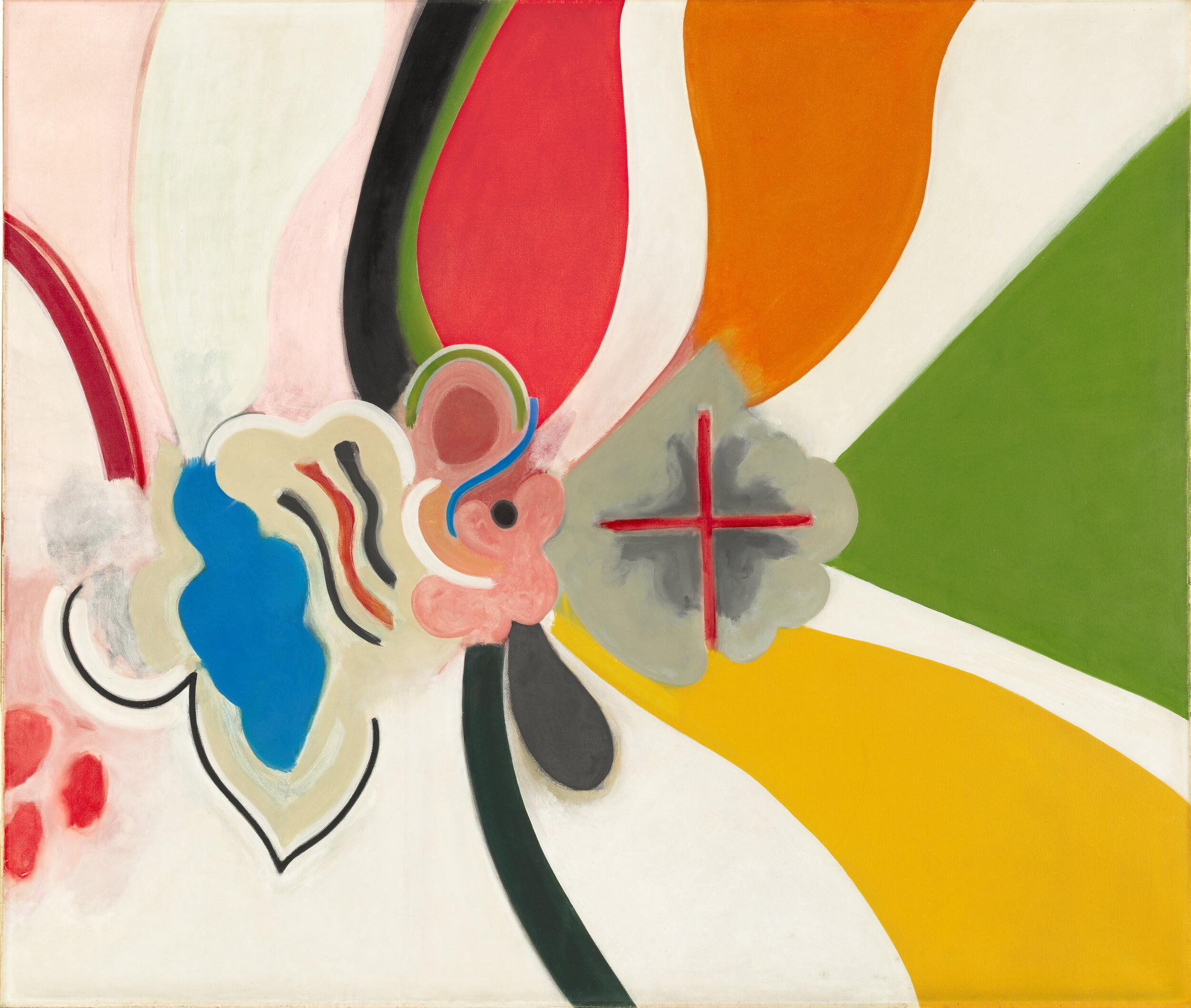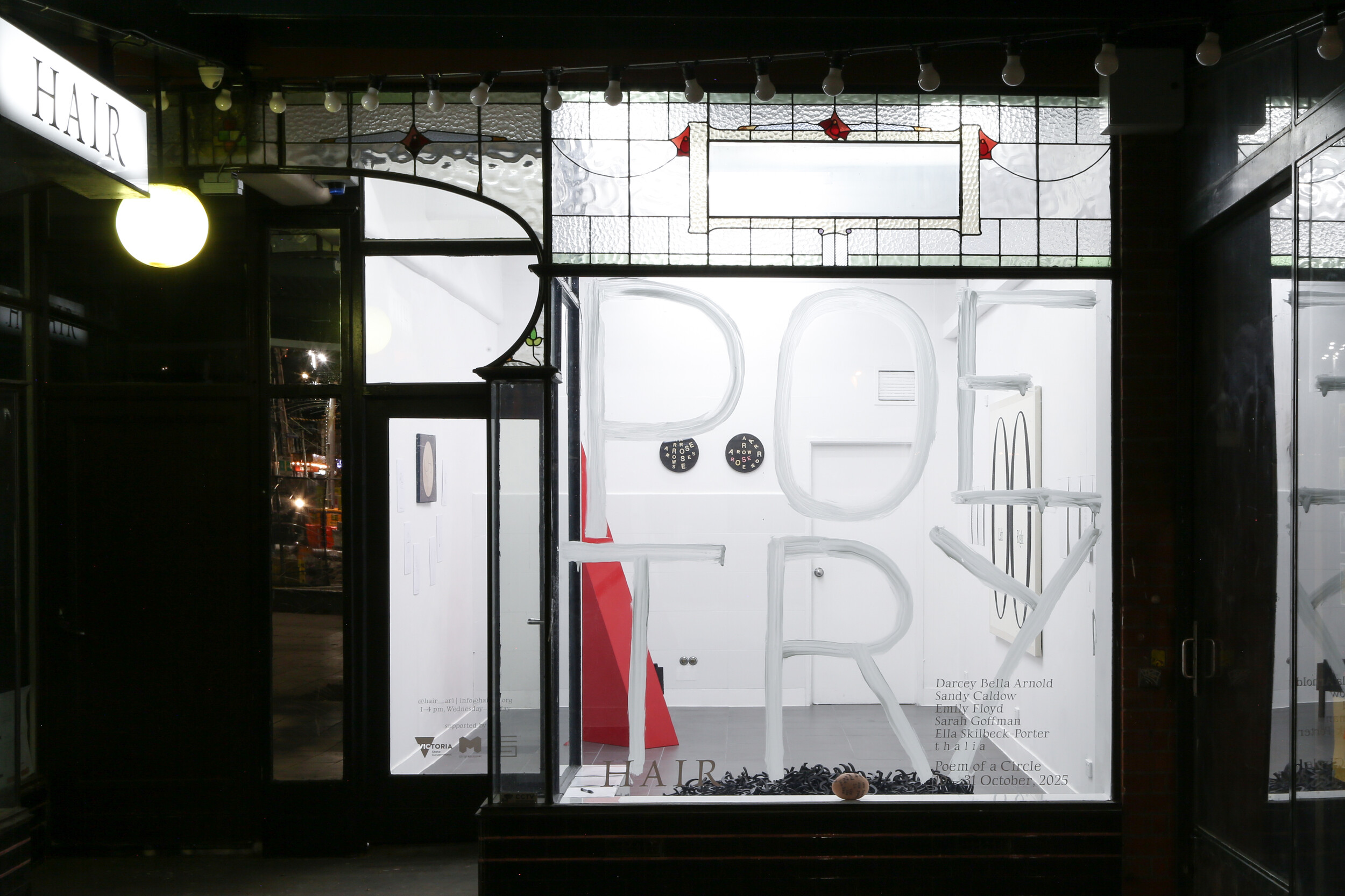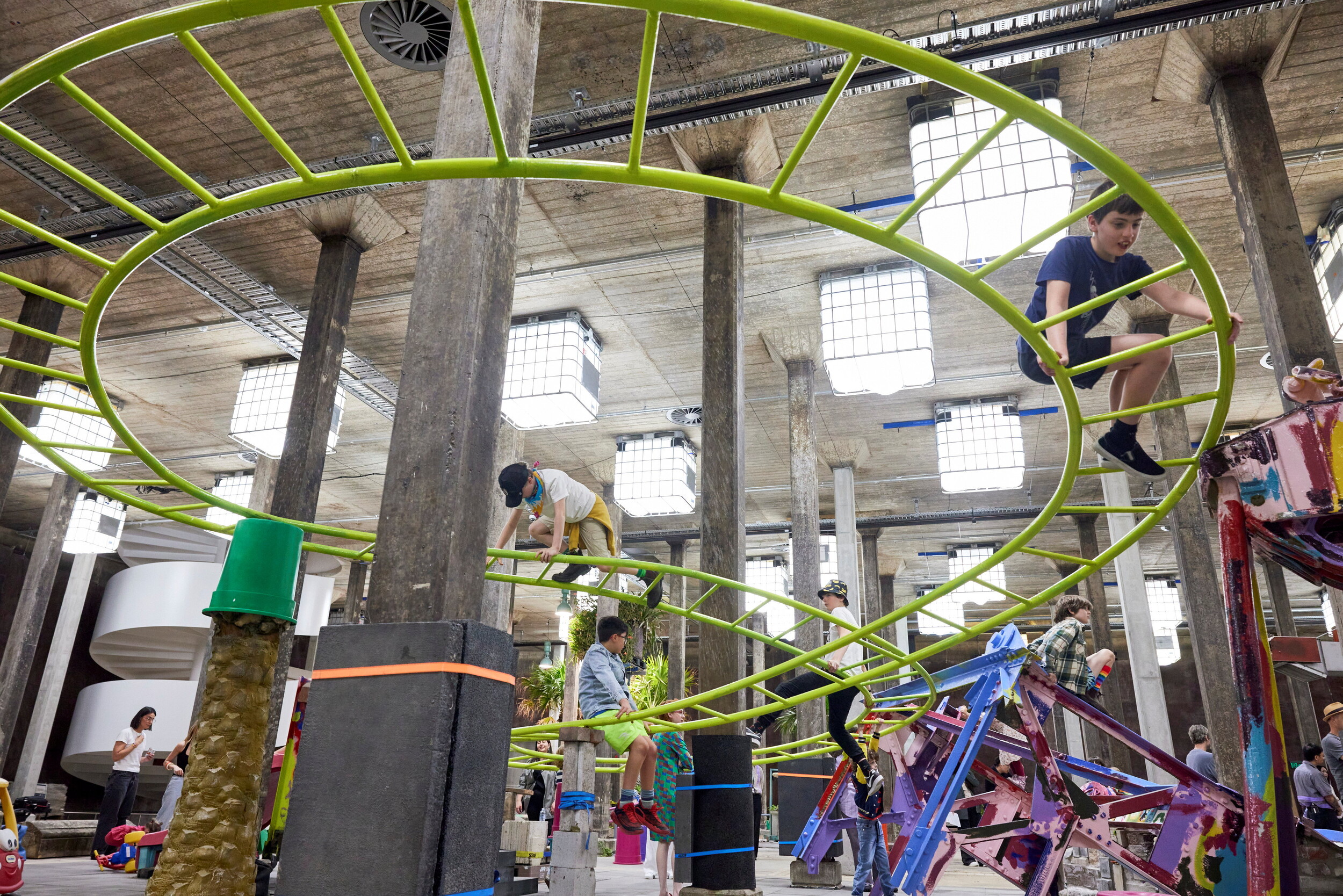Installation view of Derek Jarman: Delphinium Days, 2025, UNSW Galleries. Photo: Jacquie Manning
Derek Jarman: Delphinium Days
Toyah Webb
The words “Imperial Dreams, Material Nightmares” are etched over a portrait of Queen Victoria. The late monarch’s face is partially obscured by a fracture that resembles a bullet hole, a shot straight in the face of empire. Yet here Victoria would seem to be a stand-in for another English ruler, whose “Victorian values” systematically destroyed the lives of working class and LGTBQ+ communities in the UK. Looking at this work, one might think of Peter Kennard’s satirical Margaret Thatcher (“Maggie Regina”)—an exquisite corpse with the body of Queen Victoria and the cold visage of Margaret Thatcher.
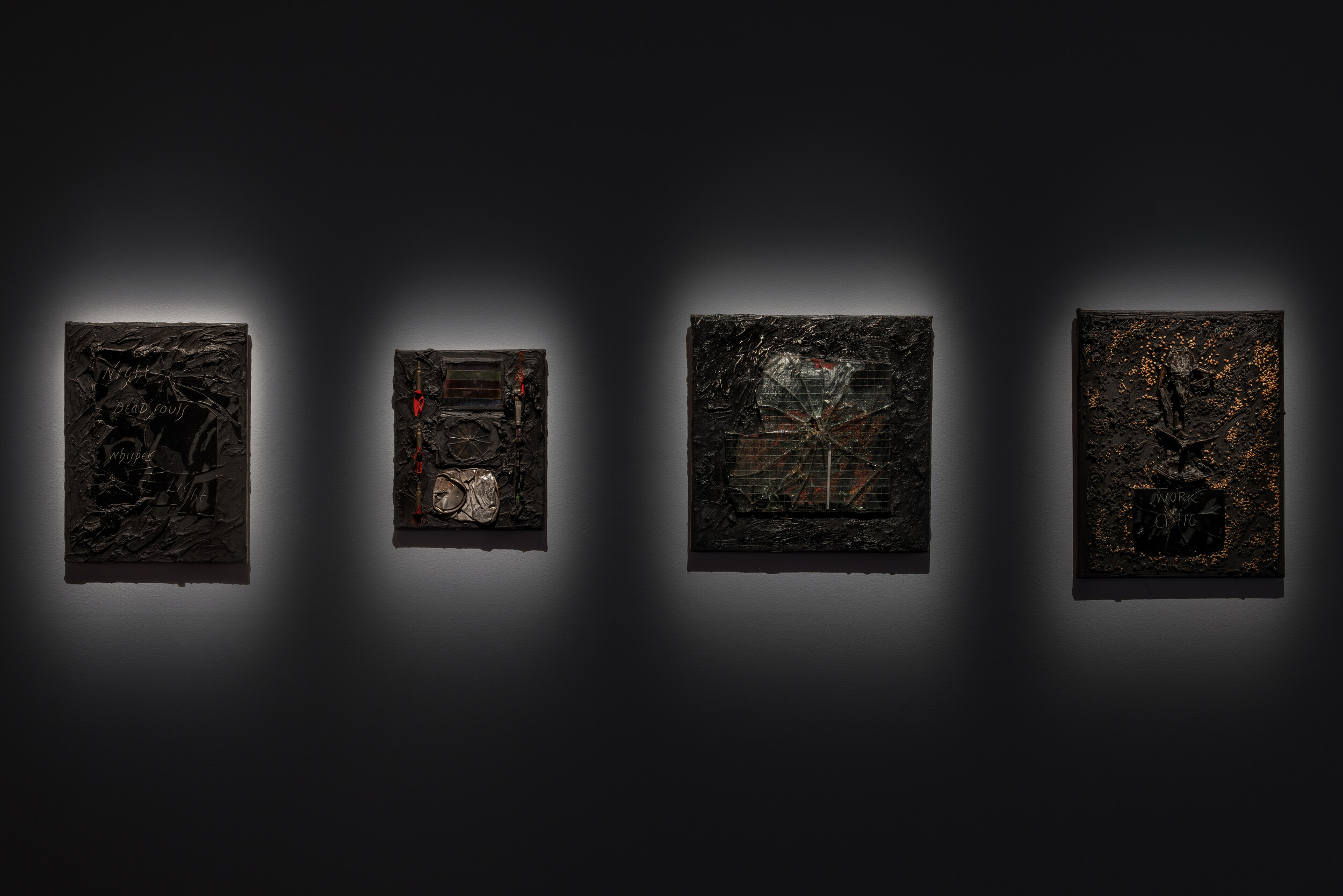
Installation view of Derek Jarman, Pinxit, 1987, oil and mixed media on canvas, Untitled (Wired Glass/Thermometer), 1990, oil on mixed media and canvas, They’ve Done It In, 1987, oil on mixed media and canvas, and The Dead Sea 11, 1986, oil on mixed media and canvas. Photo: Jacquie Manning
Imperial Dreams, Material Nightmares (1988) is one of the ten Black Paintings included in Delphinium Days at UNSW Galleries, the first retrospective of Derek Jarman’s work to be shown in Australia, thirty-one years after the artist’s death in 1994. Painted following Jarman’s AIDS diagnosis and his father’s death in 1986, the Black Paintings remind me of a blocked storm drain, where trash, dead leaves, and other organic matter cohere into a toxic sludge. Bubbling up from the black canvases are bullet casings, rusting cans, and a toy fighter plane—the latter a reference to Jarman’s father Lancelot Elworthy, who served in the RAF after emigrating from Aotearoa. There is a scene, about thirty minutes into Jarman’s 1987 film The Last of England, that depicts someone smearing a canvas with a viscous black substance. The angle isn’t great, but it looks like it could be an earlier iteration of the 1986 Black Painting, The Dead Sea 11.
Clogged with the refuse of the British empire, the Black Paintings also channel Jarman’s rage at Margaret Thatcher’s government, which came to power in the UK following the 1979 general election. Thatcher’s austerity measures—intended to “save” the British economy—included the privatisation of nationalised industry, the expansion of the free-market, and, famously, union busting. However, despite promises of growth, Thatcher’s neoliberal policies resulted in the collapse of British industry and mass unemployment, forcing England’s working poor further into the social margins.
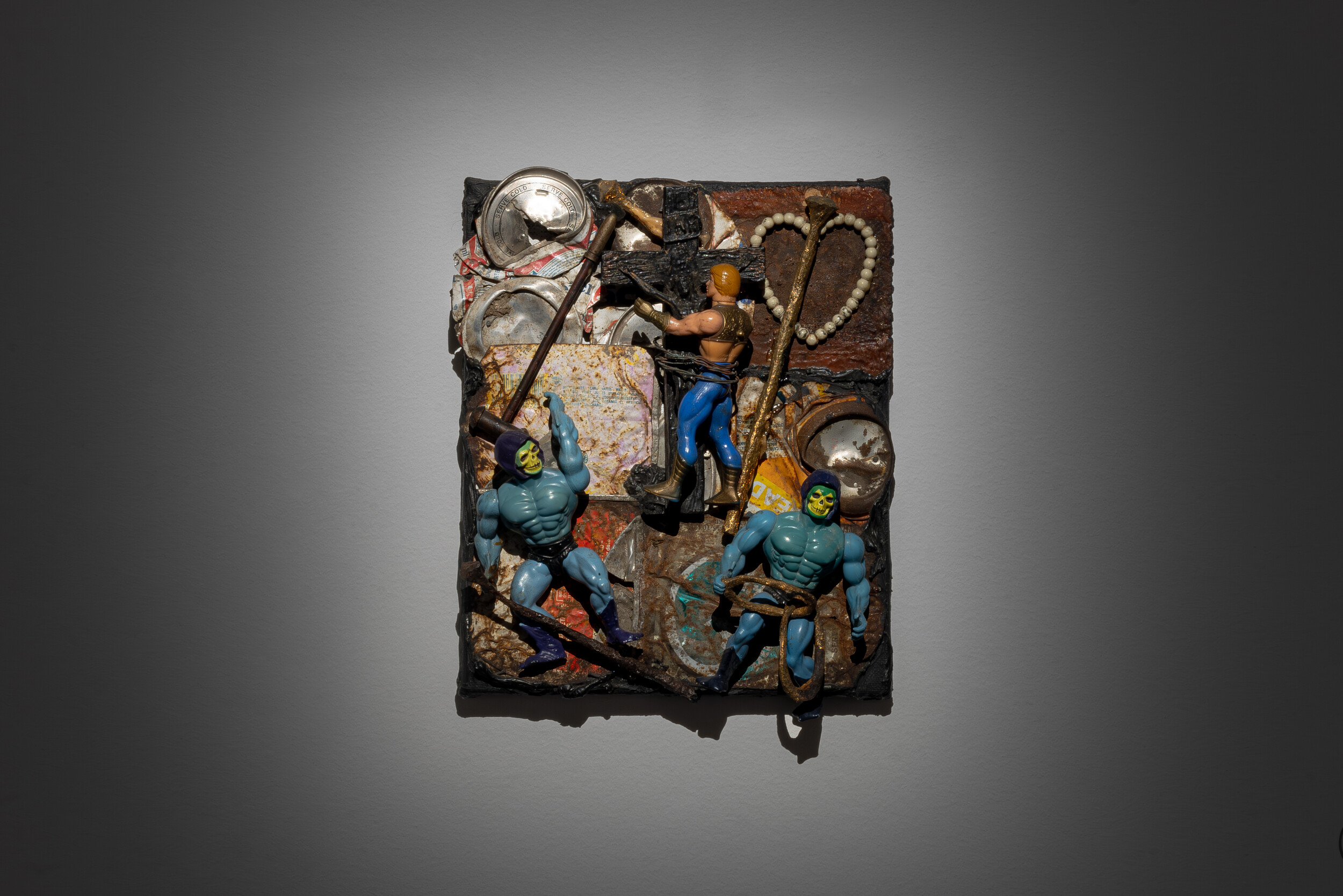
Derek Jarman, I.N.R.I., 1988, oil and mixed media on canvas. Photo: Jacquie Manning
In Delphinium Days, Jarman emerges as a gleaner, sifting through the industrial ruins of Thatcher’s Britain. Jarman found Thatcherism abhorrent; but, like for many of those crushed beneath her iron fist, this radically altered landscape was also his home. During the seventies, the artist lived in three different warehouses along the River Thames, at Upper Ground, Bankside, and Butler’s Wharf. In various stages of decay and dereliction, these liminal spaces were sites of inspiration and protest for Jarman, often serving as backdrops for his “anti-Thatcher” films.
In Jordan’s Dance (1977)—one of the two Super 8 films projected in the middle of UNSW Galleries’ main room—Jarman’s friend Pamela Rooke dances around a burning pyre dressed in a tutu. It is difficult to make out at first, but a close-up reveals a British flag in the pyre’s centre. As Rooke pirouettes, a man in a black suit periodically enters the frame to throw books on the fire, while two masked figures watch the dance. The shell of an abandoned building—the spectre of industry—looms over the scene, evoking the rubble-strewn lots in Jubilee (1978), the first of Jarman’s political “state of the nation films” (he in fact later re-edited Jordan’s Dance and included the footage in Jubilee). Although screened silent, the room sheet notes that Jarman suggested the film be set to Brahms’s Violin Concerto. I hum this as I watch the Union Jack burn.
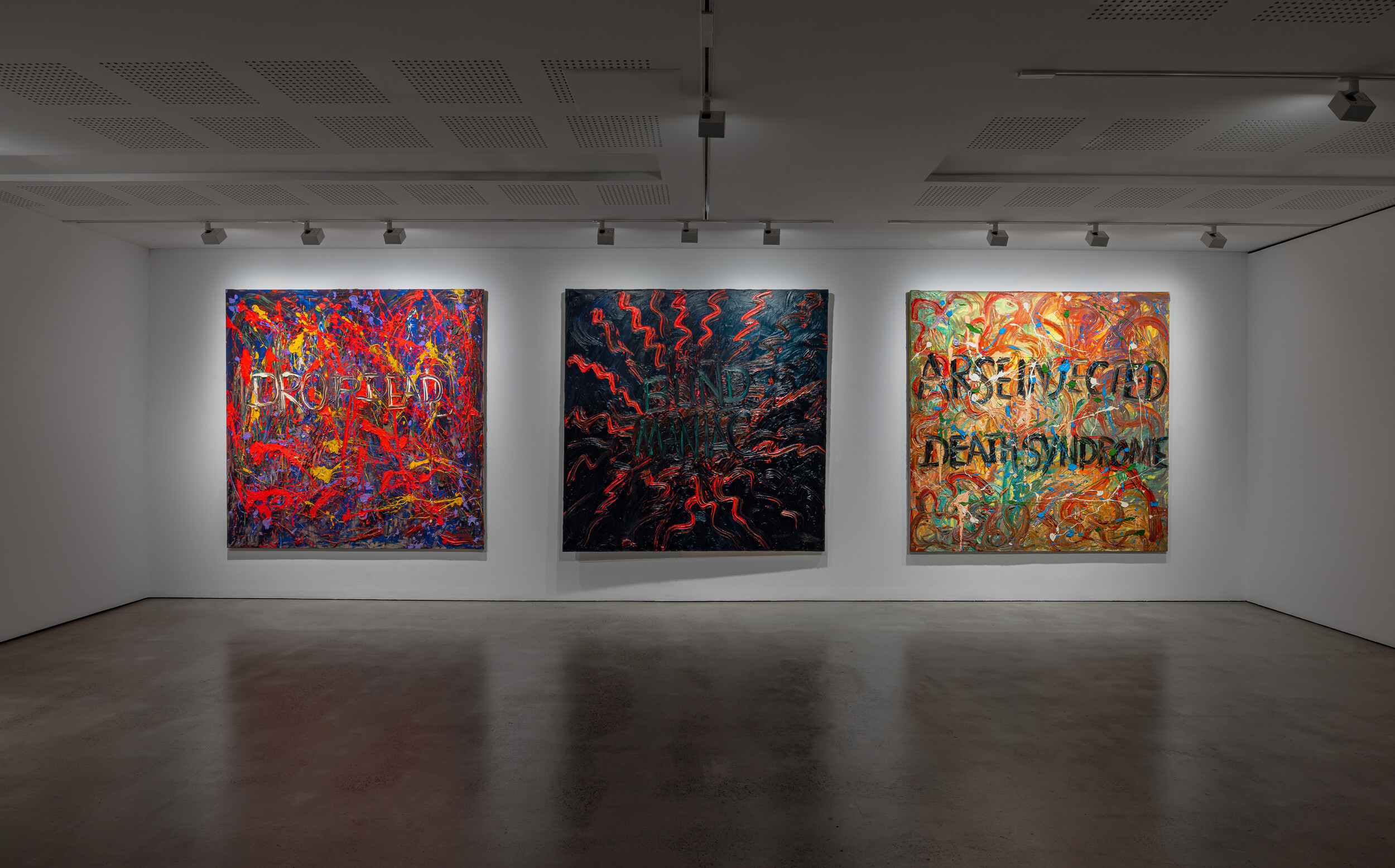
Installation view of Derek Jarman, Drop Dead, 1993, oil on canvas, Blind Maniac, 1992, oil on canvas, and Arse Injected Death Syndrome, 1993, oil on canvas. Photo: Jacquie Manning
Evil Queen was Jarman’s final series of paintings before his death from complications related to HIV AIDS. These are ugly and urgent works, which hold a (lurid, impasto) mirror up to Thatcher’s homophobic and hateful Britain. In 1987, a British Social Attitudes Survey found that seventy-five percent of the British population agreed that homosexuality was “always or mostly wrong.” One year later, Thatcher implemented Section 28, which prohibited schools and local authorities from “promoting homosexuality” or publishing material “with the intention of promoting homosexuality.” Section 28 was celebrated by England’s increasingly conservative media outlets, which published opinion pieces and articles denigrating those suffering from AIDS (the curators of Delphinium Days speculate that the title of Jarman’s painting ARSE INJECTED DEATH SYNDROME (1993) was taken from one of these tabloids). Britain’s homophobia, which Thatcher both fuelled and legislated, had devastating effects for the LGBTQ+ community, particularly those living with AIDS, who were pushed further into the social margins and cut off from access to the few social services available to them.
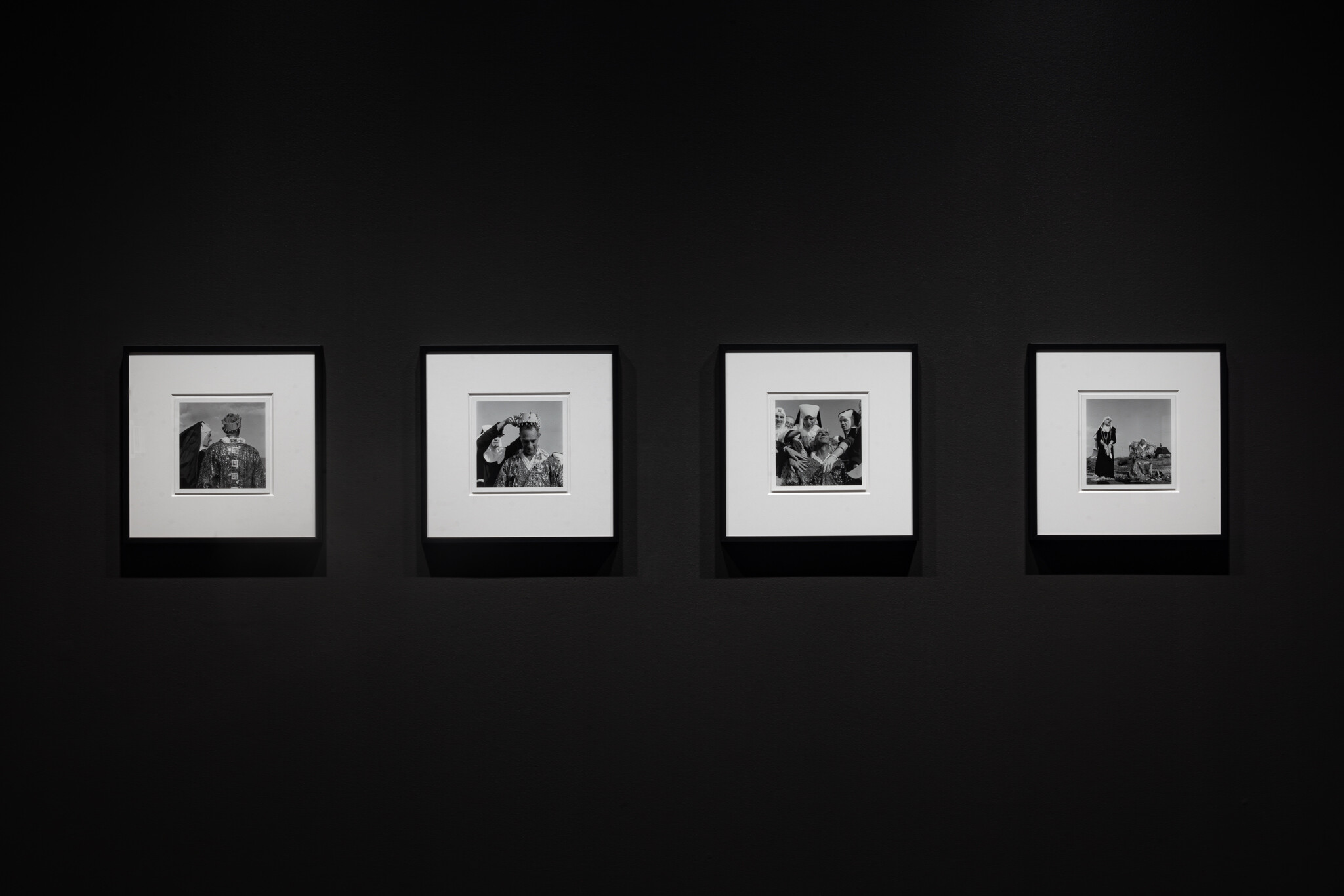
Installation view of Gordon Rainsford, Derek Jarman’s canonisation by The Sisters of Perpetual Indulgence, 1991, photographic prints. Photo: Jacquie Manning
By the time the paintings in the series Evil Queen were produced, Jarman had already begun to lose his vision, a process he documents in his final film, Blue (1993). Struggling to see the canvas, Jarman instructed his friends in the same the same way he might direct actors, who were often also friends. In Jarman’s work, there are friends on screen, off screen—poised at the edge of every frame. While Evil Queen is a series about destructiveness of hate, the paintings are not without tenderness. Confronted by these paintings, I am reminded of Judi Dench reciting Shakespeare’s thirtieth sonnet in Jarman’s intimate film The Angelic Conversation (1985):
When to the sessions of sweet silent thought
I summon up remembrance of things past,
I sigh the lack of many a thing I sought,
And with old woes new wail my dear time’s waste:
For precious friends hid in death’s dateless night
At the end of sight, Jarman’s “precious friends” slowly fade into “death’s dateless night”—but this nocturnal vision still resists, in Jarman’s words, “the long, dark night of Margaret Thatcher.”
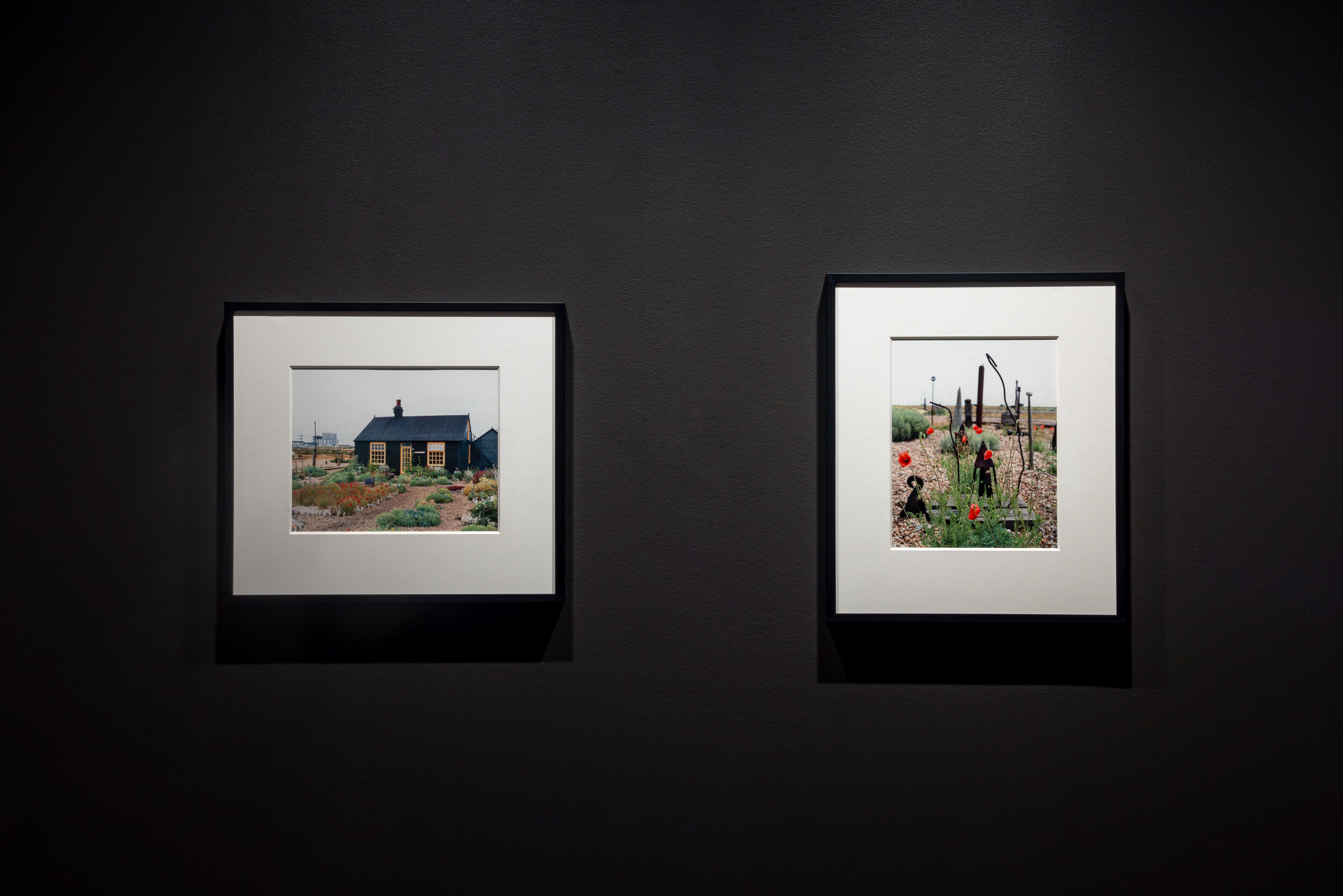
Installation view of Howard Sooley, Prospect Cottage, and Dungeness, 1991–93, photographic prints. Photo: Jacquie Manning
Included in the archival materials on display in Delphinium Days are photographs of Jarman’s 1991 canonisation by the Sisters of Perpetual Indulgence, an order of queer and trans nuns. The photographs, taken by Gordon Rainsford and Denis Doran, show Jarman—“the first living gay saint in Britain”—with his face raised to the sky, wrapped in the sequined robe from Edward II. In another, the new saint sits on a makeshift throne, cradling an inflatable Christ. Prospect Cottage is visible in the background, while the foreground is populated by the flotsam lovingly placed at Jarman’s feet. This is the artist as he would appear in a stained glass window: a queer, Elizabethan saint with a halo of trash transmuted into holy relic.
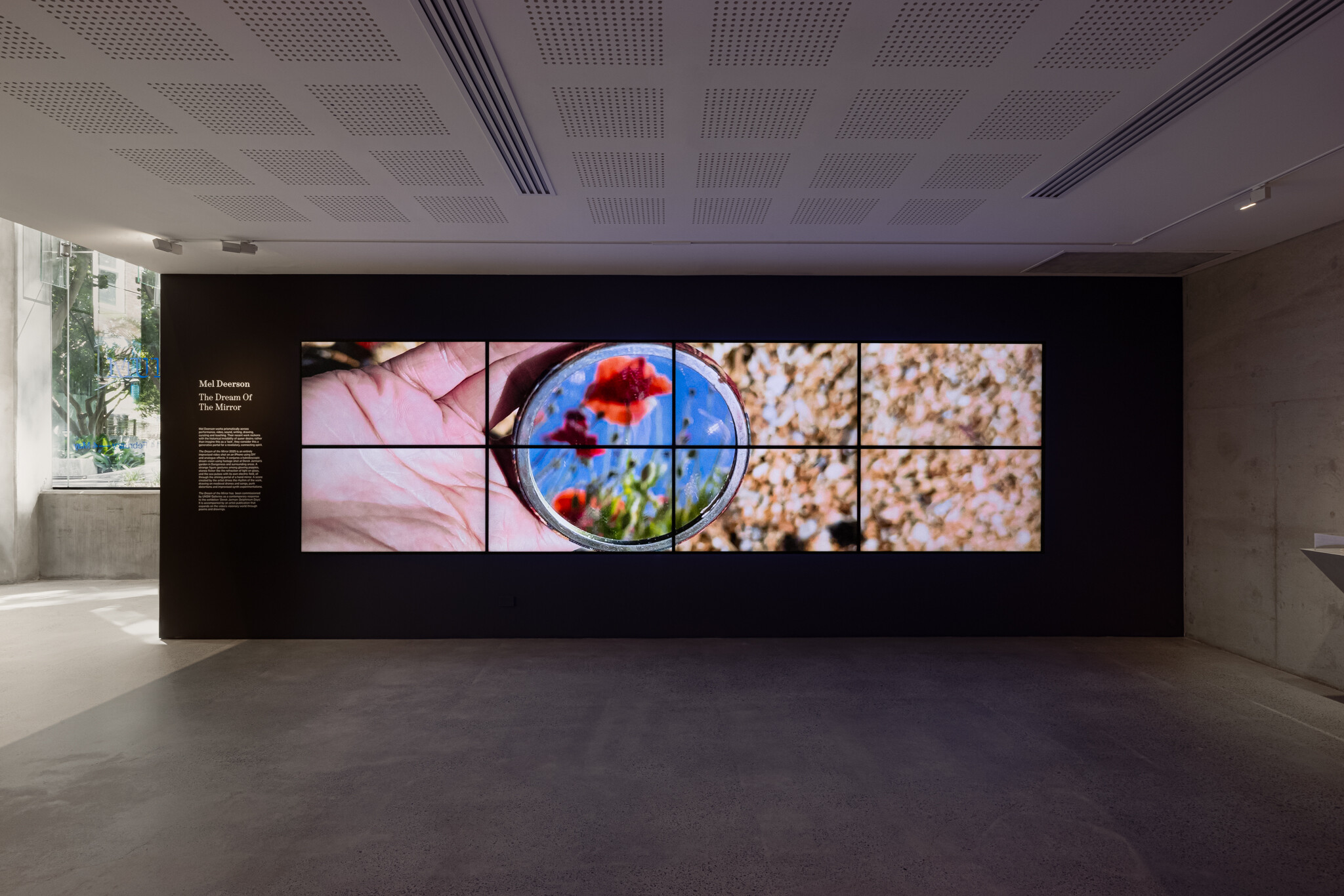
It is not surprising that Prospect Cottage, Jarman’s home from 1987 until his death, has since become a place of pilgrimage. Installed in the gallery’s atrium and commissioned specially for the show, Mel Deerson’s new video, The Dream of the Mirror (2024), was filmed on-site in Jarman’s garden at Prospect Cottage. With kaleidoscopic footage and a soundtrack of whispered Old-English poems, Deerson’s video is a spell-binding tribute to Jarman’s “medieval modern.”
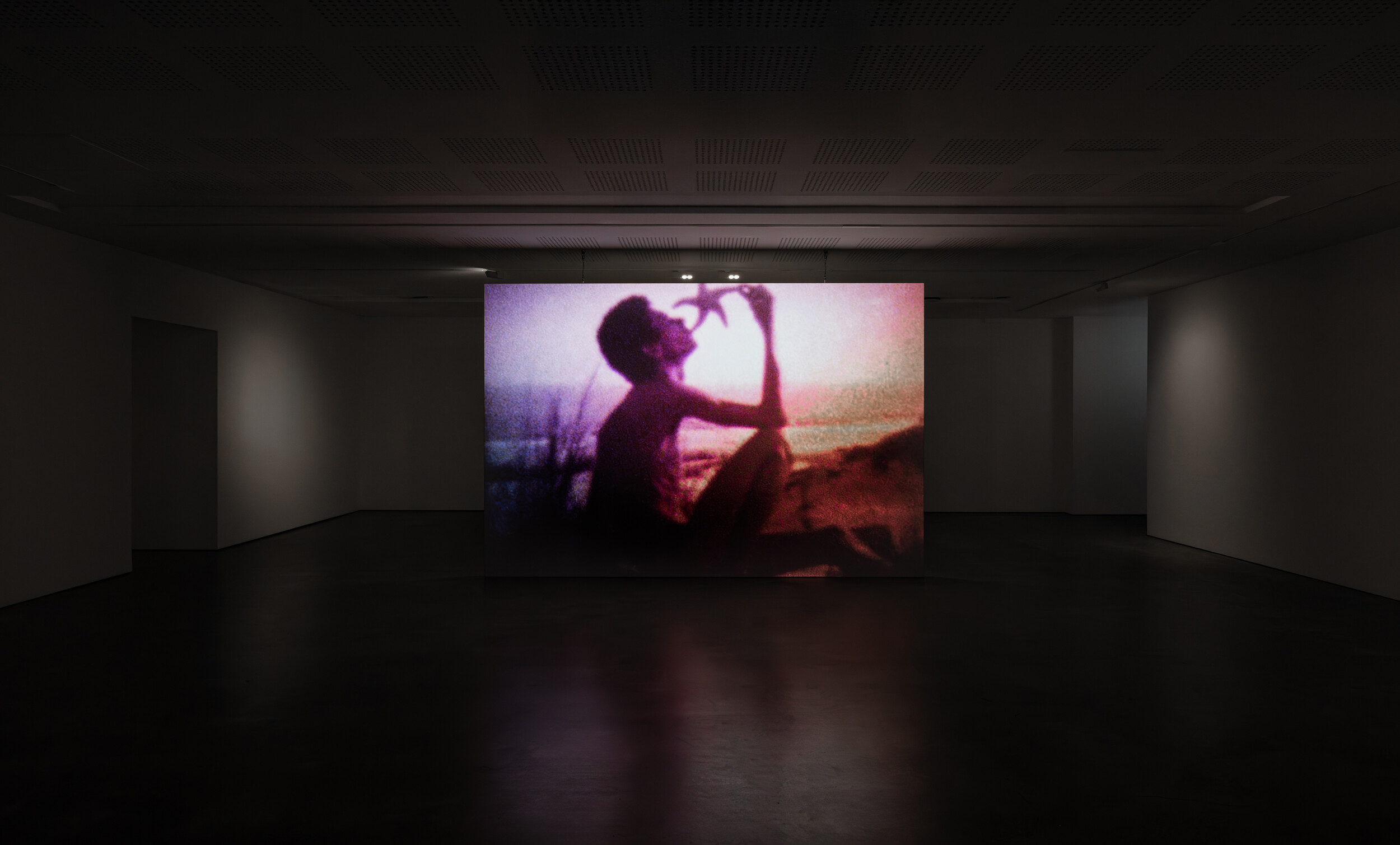
Installation view of Derek Jarman, My Very Beautiful Movie, 1974, moving iimage, Photo: Jacquie Manning
Back in the main room, the soundtrack of Blue floats into the gallery. Hazy and indistinct, I hear Erik Satie, seagulls, a harp, a hospital. As I leave, I stop before My Beautiful Movie (1974). Against the sea’s salty horizon is the silhouette of a man, with—in poet Sholto Buck’s words— “a starfish curling in his hand.”
Toyah is a writer and PhD candidate living on unceded Wangal land.
